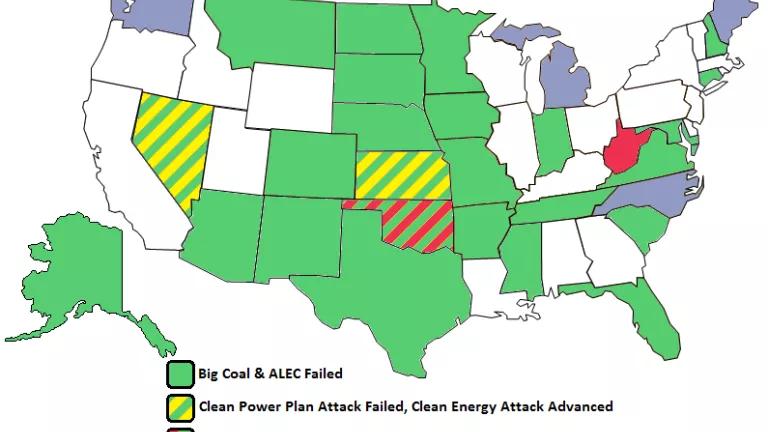
The end of spring coincides with the adjournment of most state legislatures. Before we all run off to plan pool parties to beat the summer heat (likely exacerbated by climate change), I'd like to take a moment and reflect on some heartening trends in state capitols. For years, the coal industry and the American Legislative Exchange Council (ALEC) have been trying to obstruct clean energy and climate solutions through legislatures. Each year these state attacks on our environment fail in almost every attempt and 2015 was no exception, as illustrated in this map.
During the 2015 state legislative sessions, ALEC and coal industry attempts to block the Clean Power Plan failed in 21 of 22 states. Clean energy attacks failed in 11 of 14 states, with limited consequences in the 3 states where attacks advanced.
(I've also provided a chart at the bottom, in case you're not a cartography enthusiast.)
Attacking the EPA's Clean Power Plan is at the top of the coal industry's agenda. The power sector is the nation's largest source of carbon pollution because coal is currently our largest (and dirtiest) source of electricity. When finalized this summer, the Clean Power Plan will establish carbon pollution limits on power plants for the first time ever - a huge, historic step forward to tackle climate change.
Through ALEC, the coal industry pushed dozens of bills that would have allowed legislators to block their own states from designing a plan to reduce carbon pollution. Thus far, in 2015 these ALEC and coal industry attacks on the Clean Power Plan have failed in 21 out of 22 states. Polluters have also been trying to thwart renewable energy policies for wind and solar development - in 2015, attempts to weaken clean energy policies have failed in at least 11 of 14 states.
Despite the deep pockets of polluters and their lobbyists, clean energy and climate solutions are prevailing in states. Renewable energy is enduring these attacks because it is good for public health, jobs, and economic growth - not to mention, the costs keep plummeting and clean energy adoption is accelerating. According to a University of Michigan poll released last week, 74% of Americans agree that state governments should require some renewable energy such as wind and solar power. Even in the very few states where polluters were able to advance a renewable energy attack, the damage is limited:
- Kansas: After two years of failed attempts to repeal or weaken renewable policies, polluters secured a hollow victory to turn the state's already-achieved renewable standard into a voluntary goal. Kansas met its renewables standard five years ahead of schedule.
- West Virginia: The legislature repealed an alternative energy standard that included fuel from burned tires. The standard was already so weak that it had nearly no impact on the state's electricity mix.
- Nevada: A bill introduced on the last day of the session (and passed close to midnight) added new and unnecessary regulatory processes that could slow Nevada's transition to clean energy, but ultimately does not undo the utility's renewables requirements.
On the Clean Power Plan attacks, all but one of the ALEC bills failed because the vast majority of states want to preserve their option to chart their own path to meeting carbon pollution standards. The Clean Air Act, which is the legal foundation for the CPP, gives states the first shot at designing their own carbon pollution plan for existing power plants. This is the same "cooperative federalism" approach used for decades to meet clean air standards, explained by David Doniger here. For this reason, ALEC bills died outright in thirteen states, and six states (Arkansas, Arizona, Kansas, North Dakota, Nebraska, and Tennessee) passed amended bills that still allow the states to submit carbon reduction plans to EPA. Only West Virginia successfully passed legislation that could actually block the state's implementation of CPP. If that happens, power plants in the Mountain State will become subject to carbon pollution limits under a federal plan.
Pragmatic governors and lawmakers understand the flexibility built into the Clean Power Plan, and they want their state to design its own clean energy future. Senate Majority Leader Mitch McConnell's plea to "just say no" has gotten very little traction. In Oklahoma, Governor Fallin has kept her options open by vetoing ALEC-style legislation and acting instead through an executive order, which can be more easily changed. In Texas, Governor Abbott said in a statement that he "offered his full support" to Mitch McConnell's efforts to stymie EPA's pollution limits, but the Governor left the door open for Texas to submit a CPP plan to EPA. In Wisconsin, Governor Walker said in a letter to President Obama that "it is difficult to envision" how Wisconsin will construct a state plan, but like the Texas governor, Walker did not take McConnell's pledge to refuse submission of a plan to EPA.
While this string of legislative fails by the coal industry and ALEC makes me optimistic for our future, we will need to continue to be vigilant and to counter these types of attacks. When the Clean Power Plan is finalized this summer, polluters will ratchet up their pressure to block state implementation. It is possible that some utilities, which have largely seemed to oppose these ALEC-style obstacles, could change their positions and begin to oppose constructive state solutions to reducing carbon pollution. If that were to happen, the state political landscape will shift considerably. While the outlook is positive, more challenges lie ahead as we take this historic bite out of our nation's carbon emissions.

